The Best Assessments for Reading: A Teacher’s Guide for How to Assess Reading
Using the right assessments for reading is crucial, but it can be confusing. This post is your go-to guide for how to assess reading the best way and make the most out of your reading assessments. There are many formative assessment types and reading tests that can give teachers valuable data and help guide instruction to exactly what the student needs.

The types of reading assessments you use can have a huge impact on student success. Pictured: Comprehensive Reading Assessment
When you assess reading, you want to make sure you are not wasting your (or the student’s) time. You want to make sure you’re actually getting the benefits of assessments and not just dancing through hoops to check off boxes. No one wants to do that!
Instead, you need assessments for reading that add value and guide instruction.
Then, the time you spend assessing reading will pay you back tenfold.
**For a super quick and informal check on what skills your students need and how to help them, try downloading this FREE Reading Intervention Cheat Sheet. It gives student characteristics to help you identify struggling readers and gives tips and activities for each skill they might struggle in.

Click here to download a FREE Reading Intervention Cheat Sheet to help guide your interventions at a glance.
Here is your Complete Teacher’s Guide for How to Assess Reading in ways that actually add value and are worth your time!
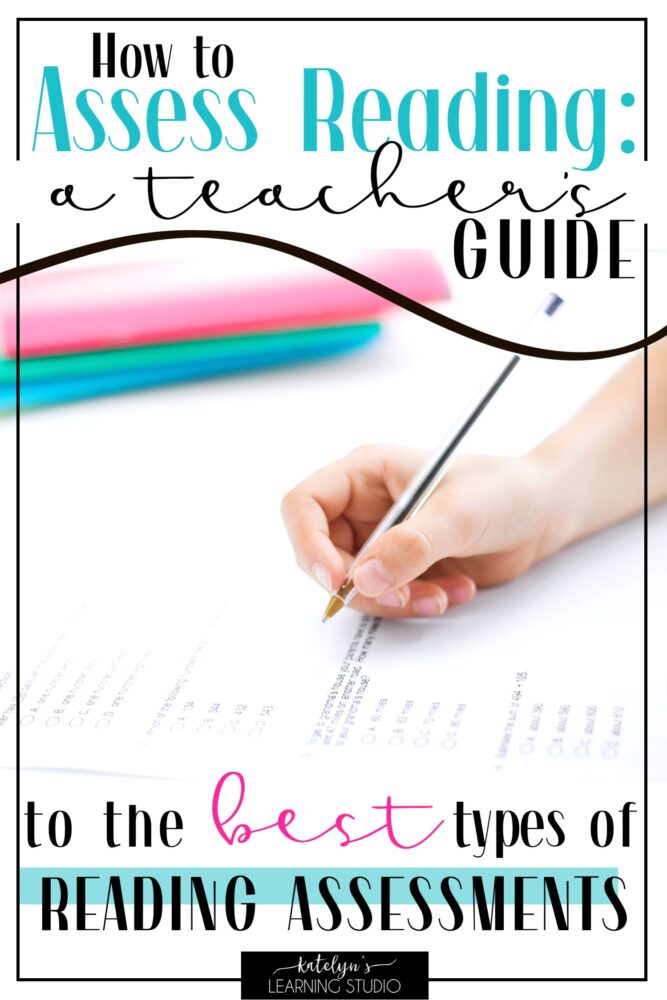
Assess reading the right way with this comprehensive reading assessment guide.
How to Make Sure Our Assessments for Reading are USEFUL:
As important as it is to assess reading, we should never just give tests for the sake of giving tests. We need to make sure we are giving USEFUL reading assessments.
What makes a reading test useful?
- It has a purpose or goal
- We are testing what we actually intend to test
- Scores are an accurate representation of the student
We’ll get into numbers 2 & 3 (targeting our intended skills and giving accurate results) in a bit, but first, let’s look at our assessment goals.
**Quick heads-up: If you are looking for a thorough and comprehensive Diagnostic Reading Assessment, this is the one I use!
Types of Reading Assessments & Their Goals
Each type of reading assessment has a different goal. We’ll choose which type of assessment to give based on our goal.
To start off with, I want to review the two big assessment types, then I will get into specific types of reading assessments.
There are 2 main categories of assessment:
- Summative Assessment: a test given to students at the END of a learning period to assess their level of achievement on a subject
- Formative Assessment: a test given to students DURING the learning period to guide instruction so that it meets the student’s needs
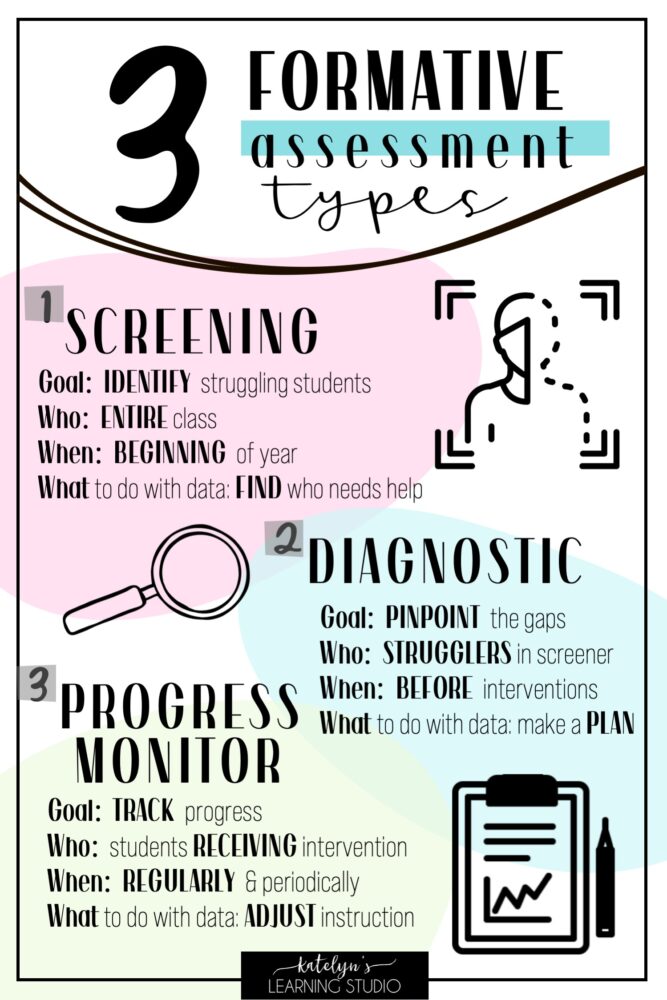
There are 3 formative assessment types that you can use to positively impact student success.
Assess Reading with Formative Assessments
Within the formative category, there are 3 smaller formative assessment types:
- Screening Assessments:
- Goal: Identify any students who are struggling
- Who: Assess the entire class
- When: At the beginning of a learning period
- What to do with data: Find students who fall below level and provide interventions
- Diagnostic Assessments:
- Goal: Figure out WHERE specifically struggling students have gaps and need intervention
- Who: Students you identified in the screener assessment
- When: After the screener but before interventions are given
- What to do with data: Make a personalized student plan to address any gaps you found
- Progress Monitoring:
- Goal: Track student progress on a specific skill
- Who: Students who are receiving intervention
- When: Regularly and periodically throughout a learning period
- What to do with data: Analyze it (see above section on analyzing data) to see how you need to adjust instruction
Here’s the Assessment System
Ideally, you give all three formative assessment types in order:
- Reading Screening: When providing reading intervention, you want to START with a reading screening assessment to identify students who are struggling.
- (I have one included in my Comprehensive Reading Assessment).
- Diagnostic Reading Assessment: Then you will give those students COMPREHENSIVE diagnostic reading assessments to pinpoint exactly which skills they need more help on.
- (again, my Comprehensive Reading Assessment includes an in-depth diagnostic test).
- Progress Monitoring: Then AS YOU PROVIDE INTERVENTION, you will give progress monitoring assessments as you go to make sure the students are making progress.
- (my Ultimate Progress Monitoring Kit helps you easily track and monitor progress in essential word-reading skills).
This can apply to whole-class reading instruction as well.
- Give the whole class a “pre-test” which can act as a screener to identify students who will need extra help during the unit.
- At the beginning of each year and up to every quarter, each student should take a comprehensive reading test to get a big picture of where their reading is at.
- Progress monitoring for the whole class then consists of traditional informal assessments given after each lesson or “end-of-week” tests to check for learning progress.
Assessments for Reading: The Best Types for Targeting Intended Skills with Accurate Results
There are 5 main areas of reading that need to be addressed for a complete reading foundation. You can read more about each of the 5 areas in this post: What are the Big 5 Reading Areas and Why You Need to Teach Them, or watch this video:
Which types of assessment are the most reliable depends on which area of reading you are assessing.
Here is where we will look at the most reliable tests to use for each reading area so that we are:
- testing the skills we actually intend to test
- our results are an accurate representation of student learning
I’ll share examples of reading assessments for each main reading area along with tips for making them as accurate as can be.
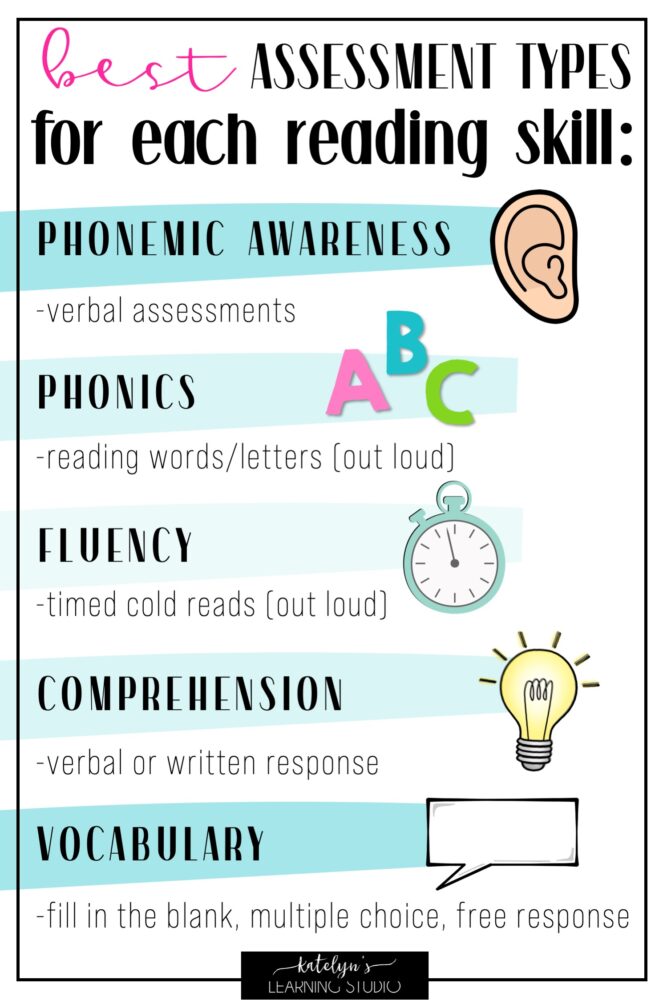
The assessments for reading you use can affect the accuracy of student scores and data.
*Note: It is important to isolate the skill you are testing so you can pinpoint exactly where their problems lie. If assessment tasks overlap different areas of reading, it will be hard to tell which area is causing the errors. Here is a FREE Reading Skills Step Ladder to help you determine which order to test reading skills in.
*Spoiler alert: You might notice a pattern with all of these assessment types! Verbal assessment is often the most reliable way to assess reading.
There’s no getting around it. When testing reading, you should have kids actually read. To get an accurate measure of how good their reading is, they need to read out loud so that you can hear it.

Assess phonemic awareness using teacher prompts and verbal student responses like in the phonemic awareness portion of this Diagnostic Reading Assessment.
1. Assess Phonemic Awareness: Verbal assessment
The easiest and most reliable way to assess phonemic awareness is through verbal prompts directly between the teacher and the student. The teacher gives a verbal task and then the student says the answer
Phonemic Awareness Assessment Example: (phoneme deletion)
- Teacher: “Say ‘dog’, then take away the /d/.”
- Studnet: “og”
Phonemic assessment deals with HEARING sounds in words. It does not involve reading or written letters at all. When we include written parts in phonemic awareness assessments, we start including phonics in the assessment.
This means phonemic awareness assessments are ideally given one student at a time directly by the teacher. Unfortunately, they take up a lot of time, but one-on-one teacher attention can also add a lot of value.
*Note: written assessments can be accurate if the student is easily able to follow directions, hold a pencil, circle, and have a good picture vocabulary. Then you can have pictures on a piece of paper and instruct students to circle the pictures that have the same beginning sounds, or the pictures that rhyme, etc.
**Also note: for a sequence of order to assess phonological awareness skills, see this blog post explaining what phonemic awareness is and the skills it includes.
Here are some strategies for phonemic awareness you can use to target these skills after you assess them.
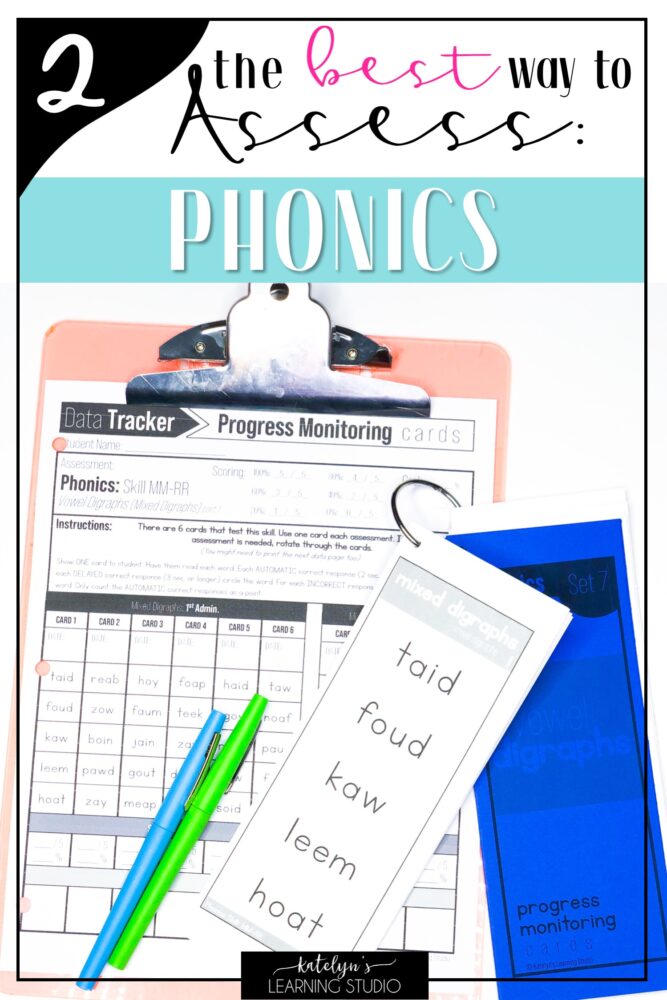
Assess phonics skills by having students read words and letters out loud, preferably nonsense words like in my Phonics Progress Monitoring Kit.
2. Assess Phonics: Verbal assessment (BEST!), short answer questions (better), or multiple choice
The best way to assess phonics is through verbal assessment, or having them read words out loud. The goal is to get students to decode words, and reading words out loud is the best way to target decoding.
The VERY BEST method is to have them read nonsense words. Nonsense words purely assess students’ phonics knowledge and decoding abilities without letting students rely on guessing from context clues and vocabulary.
When you use real words, students can use advanced language skills to read the first couple of sounds and then guess the words. This does not give us an accurate measure of their decoding skills. (It’s advanced language skills and guessing like this that create the “Compensator-Type” struggling readers. Learn more about compensators and how to help them in this blog post: Using the Science of Reading to Overcome Reading Difficulties.)
I use only nonsense words in my Phonics Progress Monitoring Kit so you can get a true gauge of your students’ phonics ability every week.
Other Ways to Assess Phonics:
You can also use short answer questions in your phonics assessments where you show a picture and have students write the word themselves. Writing words is a higher level than reading words, so you will get more students who struggle with this method. However, any student who can produce the word in writing will also be able to read the word, so your high scores will be reliable.
Multiple choice is one more option that technically could be used to assess phonics, but please be especially careful with this one!
- Do not: show a word and have students circle the picture it matches.
- This is fine for occasional activities, but please do not use this as a phonics assessment. This will not assess their phonetic decoding skills. It will only assess their deductive reasoning skills as they read the first few sounds and find the picture that starts with the same sounds. Kids are really good at guessing!
- Better, but still… : Showing a picture and having them circle the word that matches is a little better.
- The words can be made to have closer similarities so the student has to read the whole word, not just part of it. Even still though, this is dangerous for isolating phonics skills and does not always give a clear assessment of decoding.
Find out How to Teach Phonics Step by Step and use these 13 Phonics Strategies You Need to Try to help teach the phonics skills that need intervention.
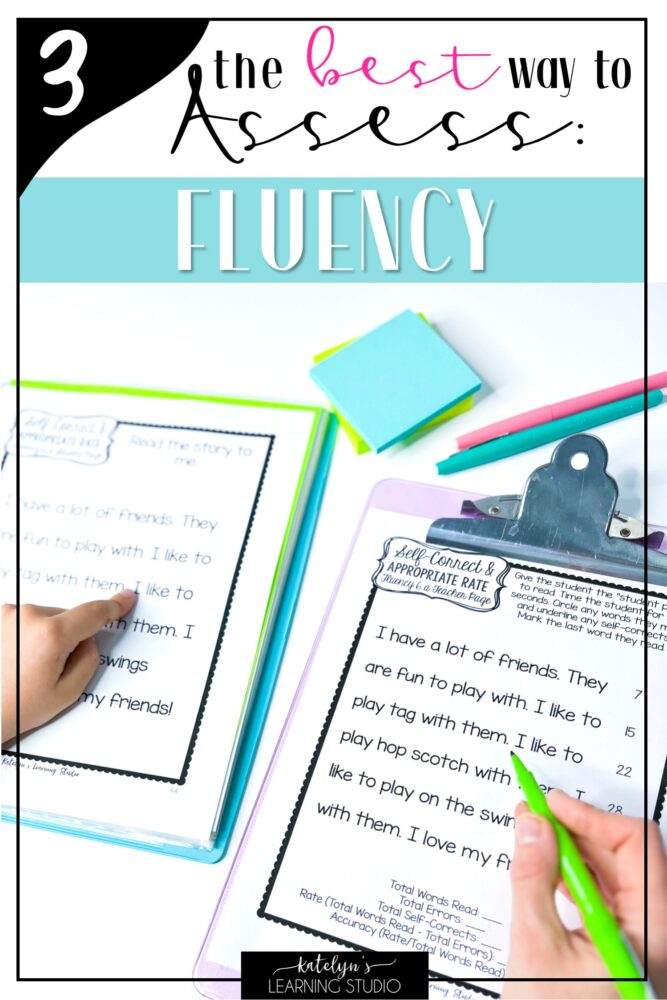
Assess fluency by testing for reading speed and accuracy rate. This Comprehensive Reading Assessment includes easy fluency test pages.
3. Assess Fluency: Oral Assessment
Fluency is one of the more straightforward reading skills to assess. Super simply explained, you have the student read (out loud so you can hear it) for a set amount of time. Then count how many words the student read.
There are 2 important aspects of fluency to track:
- Words read per minute
- Accuracy rate
Both are important to consider and give valuable insight into what the student needs.
How to Test for Reading Speed (Words Read per Minute)
- Give the student a new text to read
- Set a timer for 1 minute (or 30 seconds if you are low on time)
- At the same time: say “Go,” start the timer, and have the student start reading
- Follow along as they read and make a tally mark for each mistake or skipped word they read
- When the timer goes off, the student stops reading (take note of the last word they read)
- Go back and count the TOTAL number of words they read
- Subtract the number of words they missed
- Now you have the Words Read per Minute score!
How to Test Fluency Accuracy Rate (Words Read Correctly)
- Find the above “Words Read per Minute” score (aka: total number of CORRECT words they read)
- Find the TOTAL number of words they read, including errors (this is step 6 of the above process)
- Divide the CORRECT number of words read by the TOTAL number of words read
- Multiply the answer by 100
- The answer is their accuracy rate (it will be a percentage % number)
I have a FREE fluency tracker students can use to self-assess their own fluency. It is so motivating for them to visually track and watch their growth!
If you’re looking for ways to help your students read more fluently, here are 11 Ways to Boost Reading Fluency.
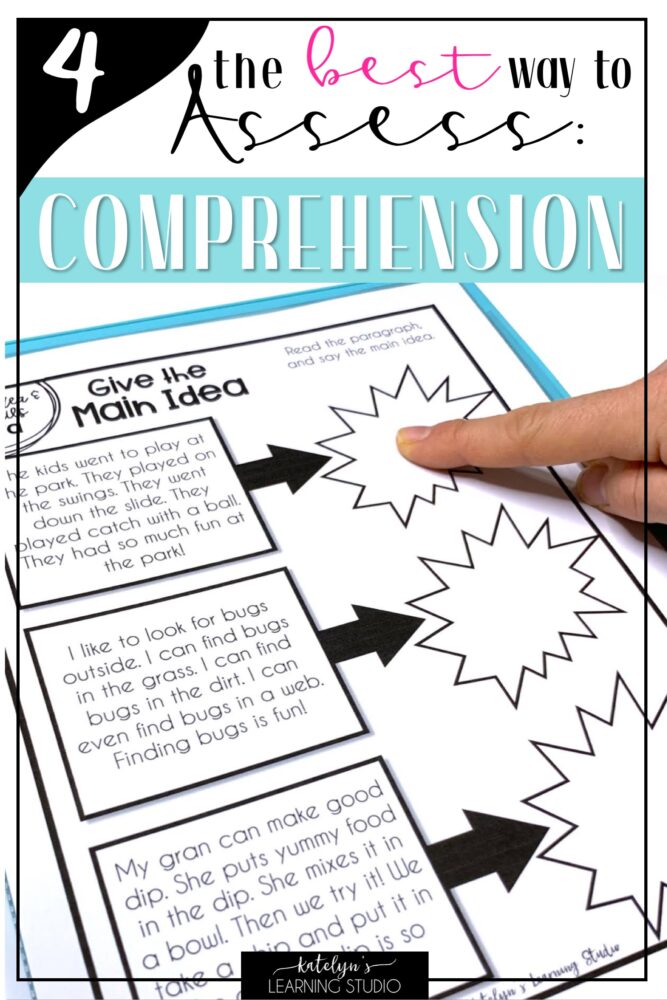
When you assess comprehension, make sure to cover both basic comprehension skills and specific comprehension strategies, like in my Reading Comprehension Intervention Binder.
4. Assess Comprehension: READ + oral response (BEST!), written response (better), multiple choice/selected response
There are two types of comprehension to consider:
- Listening Comprehension (teacher reads text, student responds)
- Reading Comprehension (student reads text and responds)
For both types of comprehension, a “free response” (the student provides a response in their own words rather than selecting a pre-written response) is best. Students are just too good at guessing.
An ORAL response is ideal. The student (or teacher for Listening Comprehension) reads the text and then verbally answers the questions. This way students are not hindered by a lack of writing skills. Writing can be overwhelming for students and the assessment becomes more of a measure of what students can write rather than comprehend.
A written response can be a good option for older students who feel comfortable explaining their thoughts in writing.
Multiple choice and selected response questions can lead students to guess, or “feed” them the answers. In a pinch though, they can provide a quick informal peek into student understanding. For a diagnostic comprehension test though, I would stick to oral responses.
Check out these strategies for reading comprehension you can use in your instruction after assessment.
Reading Comprehension Test
For a reading comprehension test, you can take several different routes.
- Basic Comprehension: Have the student read the text and tell you everything they remember about it
- Specific Comprehension Strategies: Have the student read the text and answer questions that target specific comprehension strategies
- Making and verifying predictions
- Identifying characters & setting
- Providing character traits
- Identifying problem/solution and cause/effect
- Summarizing
- Identifying the main idea
- Providing details that support a main idea
My Reading Comprehension Intervention Binder has LOADS of practice in each of these areas and comes with data tracking sheets so you can use it as a formative assessment!
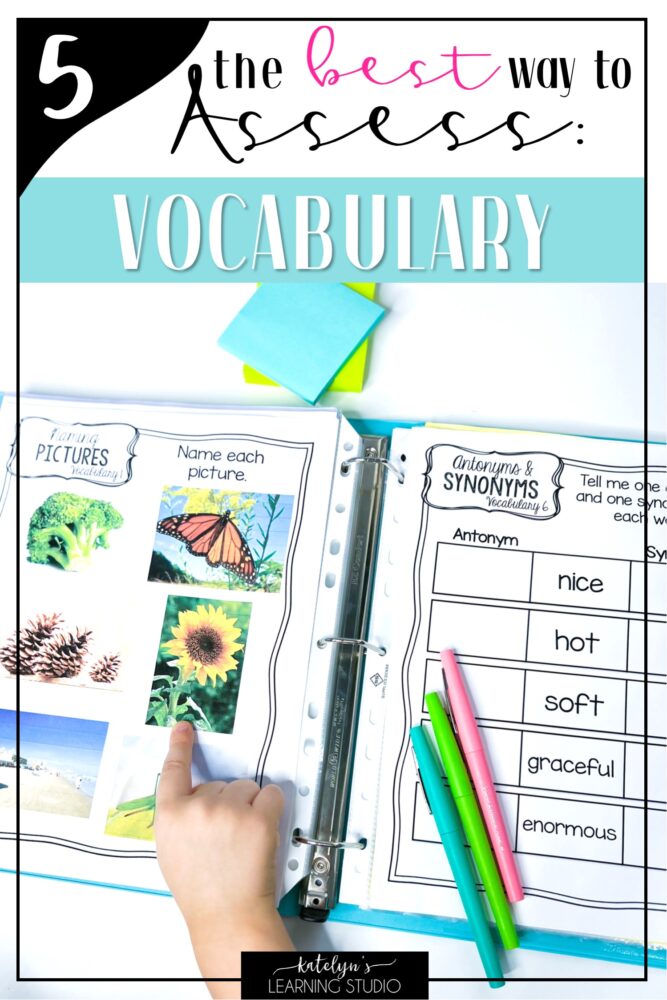
Assess vocabulary by using fill-in-the-blank, multiple-choice, or short-answer questions like in this ready-made vocabulary assessment.
5. Assess Vocabulary: Fill in the Blank, Multiple Choice, Free Response
Vocabulary is a little different when it comes to assessment. Using context clues is part of having a strong vocabulary. They don’t always have to know the exact dictionary definition for each word, but they should know how to use words and understand them in context. We still don’t want them randomly guessing, but using context clues is definitely okay.
For more ideas on ways to teach vocabulary strategies, see this post.
Ways to Assess Vocabulary:
- Fill in the Blank: Have a sentence with a word missing. Student fills in the blank with an appropriate word
- To test recall: no word bank
- To test recognition: include a word bank
- Multiple Choice: Give a definition and let students choose the word that best matches the definition
- This hones in on testing specific words.
- Free Response:
- You can say a word, use it in a sentence, and have the student explain what they think the word means (assesses word knowledge and context clues)
- OR, say a word and ask the student to use it in a sentence (assesses word use)
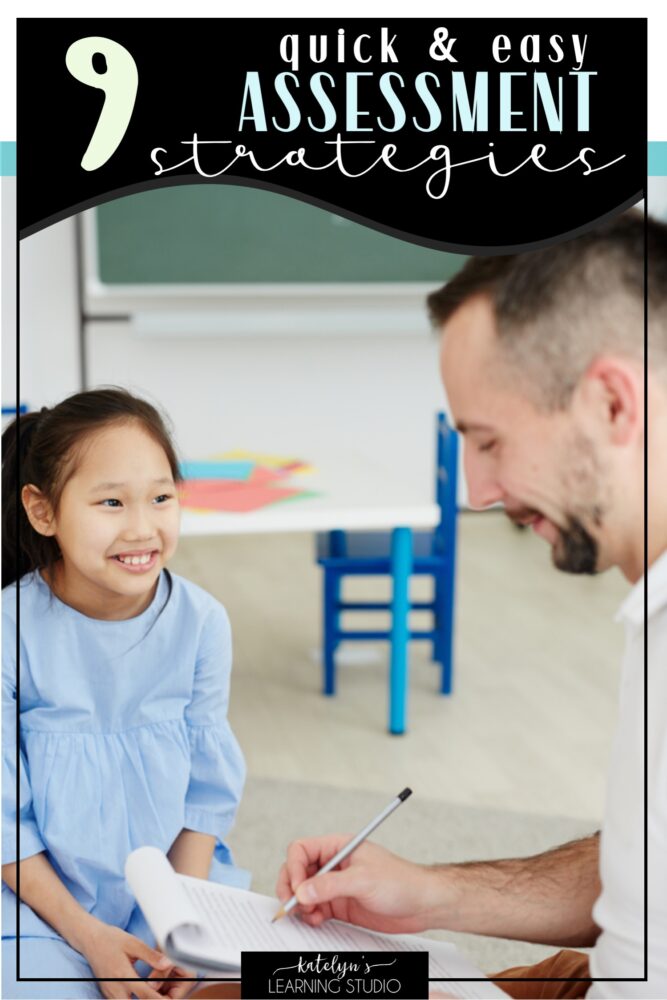
These assessment strategies will help make your assessments easier and more reliable.
Assessment Strategies in the Classroom
I want to end with some basic assessment strategies you can use in the classroom when assessing reading with students. These will help your test results be more accurate and useful.
- Stay positive! The moment they feel like they are failing, students will shut down and not perform well.
- Make your assessments to the point (no fluff or extra teacher talk).
- Make sure students understand the directions.
- Do an example AND a practice question to double-check they understand what to do.
- Make sure your assessment aligns with what you actually want to assess.
- Make it short and sweet so students don’t get burnt out.
- Cover half the page to only show a little of the assessment at a time (so they don’t get overwhelmed).
- Underline each question with a blank piece of paper to help them stay focused.
- Have them use their finger to point to which question they are on (or the text as they read) to stay focused.
When you pick the right assessments for reading and use the right assessment strategies in the classroom, it can add so much value to your teaching. The way you assess reading can guide your instruction and give you valuable information as long as you are using the right types of reading assessments. So don’t shy away from that reading test if you need more information on how to best help your student!
